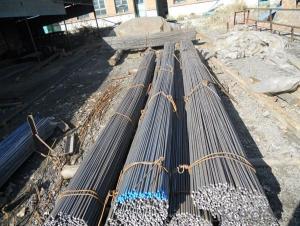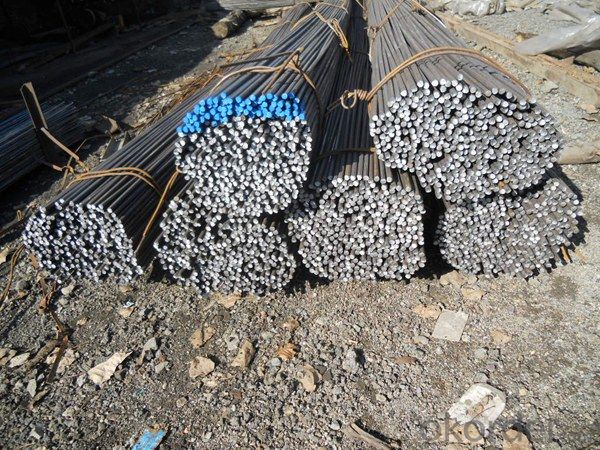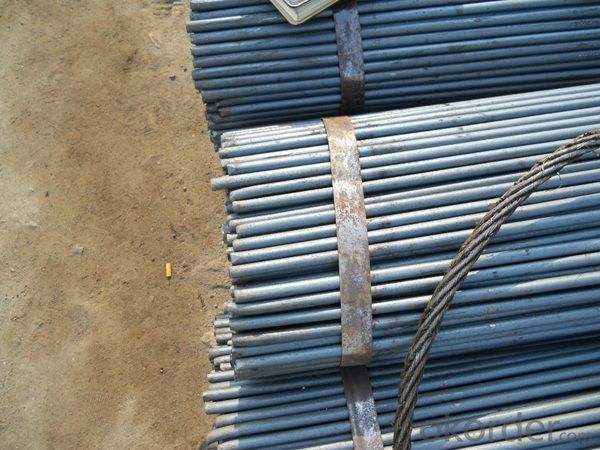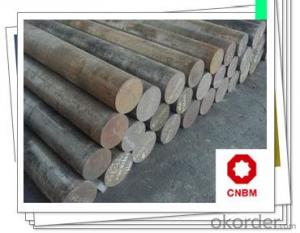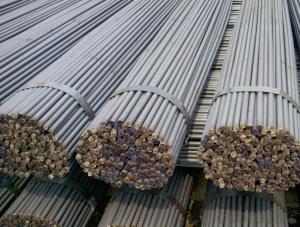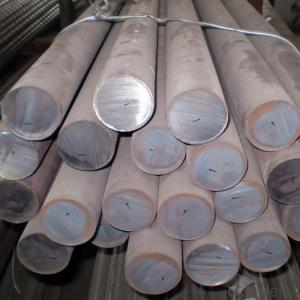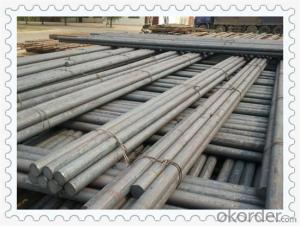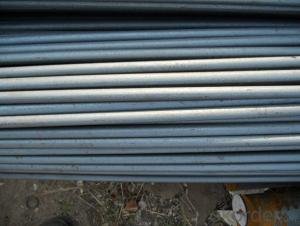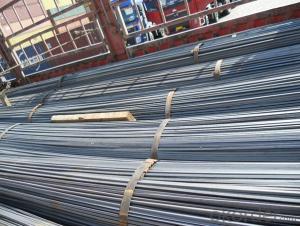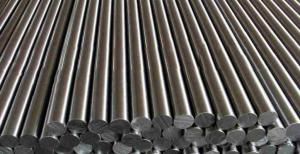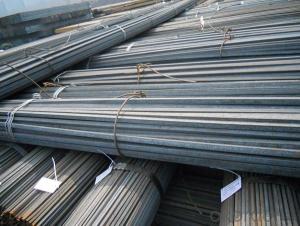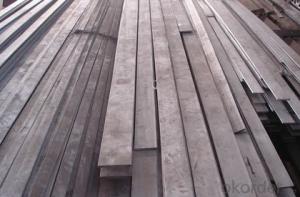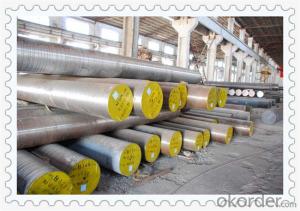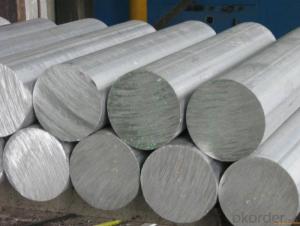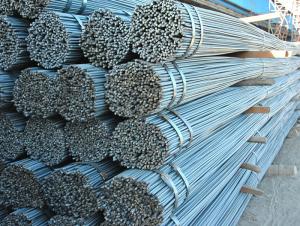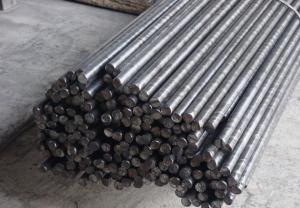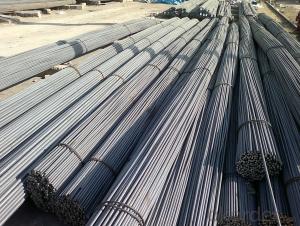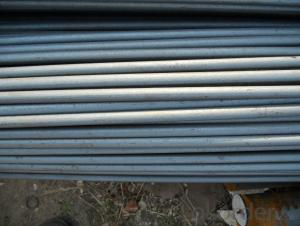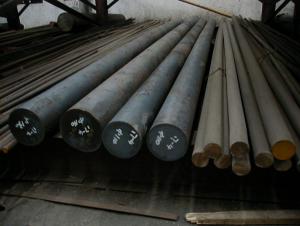Mild Hot Rolled Steel Round Bars for Bults and Nults
- Loading Port:
- Tianjin
- Payment Terms:
- TT or LC
- Min Order Qty:
- 25 m.t.
- Supply Capability:
- 200000 m.t./month
OKorder Service Pledge
OKorder Financial Service
You Might Also Like
Product Description:
OKorder is offering high quality Mild Hot Rolled Steel Round Bars for Bults and Nults at great prices with worldwide shipping. Our supplier is a world-class manufacturer of steel, with our products utilized the world over. OKorder annually supplies products to European, North American and Asian markets. We provide quotations within 24 hours of receiving an inquiry and guarantee competitive prices.
Product Applications:
Mild Hot Rolled Steel Round Bars for Bults and Nultsare ideal for structural applications and are widely used in the construction of buildings and bridges, and the manufacturing, petrochemical, and transportation industries.
1. Steel round bar products is used in construction and a large number of architectural and engineering structures. And it can be used in production of handrail, windows, machinery, telecom and curtain wall.
2. It can be used in the fields like metal mines, cement plants, water coal slurry, power stations and chemical industry.
3. Besides, we can supply some especial material steel round bar that can be used for main shaft of steamer, hummer shank, with big section and supper force.
4. Recommended watchcase factory, screw factory and other cold stamping products industry use.
Product Advantages:
OKorder's Steel I-Beams are durable, strong, and resist corrosion.
1. The steel in which the main interstitial alloying constituent is carbon in the range of 0.12–2.0%.
2. As the carbon percentage content rises, steel has the ability to become harder and stronger through heat treating; however it becomes less ductile.
3. Regardless of the heat treatment, higher carbon content reduces weld ability. In carbon steels, the higher carbon content lowers the melting point.
4. Quality should be in conformity with the specification of the manufacturer. Quantity and packing conditions should be in conformity with the term in the contract.
Main Product Features:
· Premium quality
· Prompt delivery & seaworthy packing (30 days after receiving deposit)
· Corrosion resistance
· Can be recycled and reused
· Mill test certification
· Professional Service
· Competitive pricing
Specifications of Mild Hot Rolled Steel Round Bars for Bults and Nults
1. Grade: Q235, A36, SS400, S235JR
2. Feature: Unbreakable, grinding resistant and high impact value
3. Diameter: 8mm-150mm
4. Performance: Mainly for civil construction
5. Characteristics: Even hardness, no deformation, no breaking, no mal-roundness
6. Technique: Hot rolled
7. Mass: Mass (kg/m) = Diameter (mm) × Diameter (mm) × 0.00617
Packaging & Delivery of Mild Hot Rolled Steel Round Bars for Bults and Nults
Packaging Detail: All goods are packed in bundle with steel strips and shipped by break bulk vessel or container (depend on target market and different ports)
Delivery Detail: 45 days
Trade terms: FOB, CFR, CIF
MOQ: 25 tons per specification; we can negotiate the quantity if the specification is normal or we have stock of one specification.
Weight: The price invoicing on theoretical weight basis or actual weight basis depends on customer’s request.
Shipment: The shipment of bulk break or container is depends on customer’s request and the situation of the port of destination.
Documents given: Full set of original clean on board bill of lading; Original signed commercial invoice; Original packing list; Policy of insurance; Certificate of origin and what the target market needs.
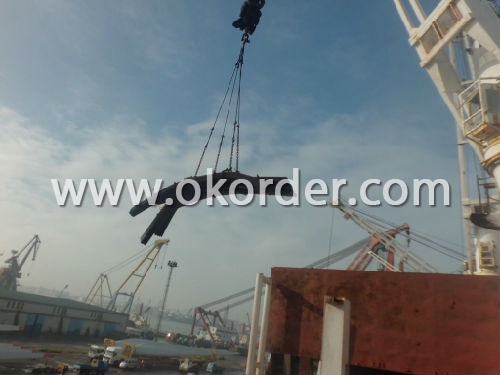
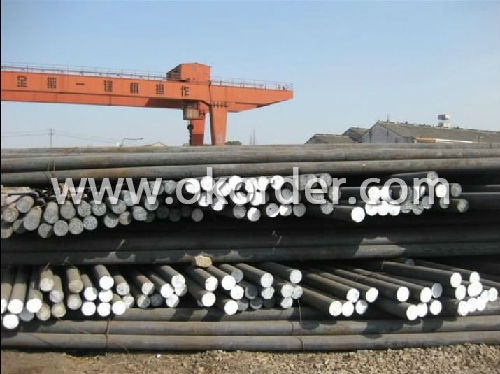
Production Flow of Mild Hot Rolled Steel Round Bars for Bults and Nults
Material prepare (billet) — heat up — rough rolling — precision rolling — cooling — packing — storage and transportation
FAQ:
Q1: The products are invoicing on theoritical weight or on actual weight?
A1: We can do it in both manners, according to the customers' request.
Q2: What is the normal tolerance of Hot Rolled Mild Steel Angle Beams for Structures and for Buildings?
A2: Normally 3%-5%, but we can also produce the goods according to the customers' requests.
Q3: How soon can we receive the product after purchase?
A3: Within three days of placing an order, we will begin production. The specific shipping date is dependent upon international and government factors, but is typically 7 to 10 workdays.
- Q: What are the advantages of using mild steel round bars?
- There are several advantages of using mild steel round bars in various applications. Firstly, mild steel round bars have excellent strength and durability. They are able to withstand high amounts of stress and pressure, making them suitable for use in construction, manufacturing, and engineering projects. The strength of mild steel round bars ensures that they do not easily deform or break under heavy loads, providing a reliable and long-lasting solution. Secondly, mild steel round bars have good weldability. They can be easily joined or attached to other materials through welding, making them versatile in different applications. This allows for easy customization and flexibility in design, as the bars can be shaped and connected to create complex structures or components. Additionally, mild steel round bars have a low carbon content, making them more cost-effective compared to other types of steel. They are readily available and affordable, making them a popular choice in various industries. Moreover, mild steel round bars have good machinability. They can be easily cut, drilled, and shaped using common machining techniques, allowing for easy fabrication and customization. This makes them suitable for a wide range of applications, from construction to automotive components. Lastly, mild steel round bars have good corrosion resistance. While they may not be as corrosion-resistant as stainless steel, they still offer adequate protection against rust and other forms of corrosion. This makes them suitable for outdoor applications or environments with high humidity or exposure to moisture. In summary, the advantages of using mild steel round bars include their excellent strength and durability, good weldability, cost-effectiveness, machinability, and corrosion resistance. These factors make them a reliable and versatile choice for various industrial and construction applications.
- Q: What is the difference between a seamless and a turned steel round bar?
- A seamless steel round bar is produced by piercing a solid billet to create a hollow tube, which is then elongated and rolled to the desired size. This manufacturing method ensures a smooth and continuous surface, without any seams or welds. On the other hand, a turned steel round bar is a solid bar that undergoes machining operations to achieve the desired shape and dimensions. It is typically produced from a larger steel bar by removing material through turning or machining processes. Therefore, the main difference lies in the manufacturing process, with seamless round bars being hollow and formed through extrusion, while turned round bars are solid and shaped through machining operations.
- Q: How do steel round bars compare to fiberglass or composite bars?
- Steel round bars and fiberglass or composite bars have distinct differences in terms of their properties and applications. Strength and Durability: Steel round bars are known for their exceptional strength and durability. They have a high tensile strength and can withstand heavy loads and stress. Fiberglass or composite bars, on the other hand, have good strength-to-weight ratio but are generally not as strong as steel bars. They may be more prone to bending or breaking under high pressure or impact. Weight: Steel bars are significantly heavier than fiberglass or composite bars. This can be advantageous in certain applications where additional weight is desired for stability or to counteract external forces. However, in situations where weight reduction is crucial, such as in aerospace or automotive industries, fiberglass or composite bars are preferred due to their lightweight nature. Corrosion Resistance: Steel bars are susceptible to corrosion, especially when exposed to moisture or harsh environments. They require regular maintenance and protective coatings to prevent rusting. In contrast, fiberglass or composite bars are inherently corrosion-resistant, making them suitable for applications in marine or chemical industries where exposure to corrosive elements is common. Electrical Conductivity: Steel round bars are conductive, which can be advantageous in certain applications where electrical grounding or conductivity is required. Fiberglass or composite bars, being non-conductive, are preferred in situations where electrical insulation is necessary, such as in electrical installations or sensitive electronic systems. Cost: Steel bars are generally more cost-effective compared to fiberglass or composite bars. The raw materials for steel production are widely available, making them more affordable in most cases. Fiberglass or composite bars, on the other hand, involve complex manufacturing processes and the use of specialized materials, leading to higher production costs. In summary, steel round bars are favored for their strength, durability, and cost-effectiveness. They are commonly used in construction, manufacturing, and infrastructure projects. Fiberglass or composite bars, on the other hand, offer advantages in terms of weight reduction, corrosion resistance, electrical insulation, and are frequently used in applications requiring these properties. The choice between the two depends on the specific requirements and conditions of the project or industry.
- Q: How do steel round bars compare to aluminum round bars?
- Steel and aluminum round bars differ in their properties and applications. When it comes to strength and durability, steel round bars surpass aluminum. Steel exhibits higher tensile strength and can withstand heavier loads and stresses, making it suitable for critical applications like construction or manufacturing machinery. In contrast, aluminum round bars are weaker and more prone to bending or breaking under heavy loads, hence they are typically used in lighter applications or when weight reduction is important. Weight-wise, aluminum round bars are significantly lighter than their steel counterparts. This quality makes aluminum a favored choice in weight-sensitive industries such as aerospace or automotive manufacturing. Moreover, the lightweight nature of aluminum round bars makes them easier to handle and transport. In terms of corrosion resistance, aluminum round bars excel due to the formation of a protective oxide layer on their surface. This layer acts as a barrier, protecting the metal from further corrosion and making aluminum suitable for outdoor applications or environments with high humidity or chemical exposure. On the other hand, steel round bars are more prone to rust and corrosion, necessitating protective coatings or treatments to enhance their resistance. In the cost department, steel round bars generally come out as the more cost-effective option. Steel is widely available and commonly used, making it more affordable in most cases. Conversely, aluminum round bars are pricier due to their production process and higher energy requirements. When it comes to thermal conductivity, aluminum round bars shine. They exhibit excellent thermal conductivity, efficiently transferring heat. This characteristic makes them well-suited for applications where heat dissipation is crucial, such as heat sinks or electrical conductors. While steel round bars do conduct heat to some extent, their thermal conductivity is lower compared to aluminum. Overall, steel round bars offer superior strength, durability, and cost-effectiveness, making them suitable for heavy-duty applications. On the other hand, aluminum round bars are lighter, possess excellent corrosion resistance, and exhibit superior thermal conductivity, making them ideal for lightweight applications and industries where weight reduction or heat dissipation are vital. Ultimately, the choice between steel and aluminum round bars depends on the specific requirements of the application.
- Q: How can steel round bars be protected against corrosion?
- Steel round bars can be protected against corrosion through various methods such as applying a protective coating, galvanizing, using corrosion inhibitors, or implementing cathodic protection. These techniques form a barrier between the steel surface and corrosive elements, preventing or slowing down the process of corrosion.
- Q: What is the difference between a seamless and a turned steel round bar?
- The manufacturing process and resulting characteristics distinguish a seamless steel round bar from a turned steel round bar. To produce a seamless steel round bar, a solid steel billet is pierced, typically through hot rolling. This creates a hollow tube-like structure that is then elongated and shaped into the desired round bar form. The absence of welded joints or seams along its length gives the seamless bar a smooth and continuous surface. This manufacturing method improves the overall strength and durability of the round bar. In contrast, a turned steel round bar begins as a solid steel bar obtained through casting or hot rolling. The bar undergoes a machining process called turning, where it is rotated against a cutting tool to remove material and achieve the desired dimensions and shape. This turning process results in a round bar with a smooth and polished surface. However, there may be mill marks or slight imperfections due to the machining process, unlike a seamless round bar. Seamless steel round bars are often preferred in industries that require high strength and reliability, such as construction, automotive, and oil and gas. Their uniform structure and absence of welds make them highly resistant to cracking and failure under heavy loads or extreme conditions. On the other hand, turned steel round bars are commonly used in applications where a smooth surface finish is desired, such as decorative pieces or precision components for machinery. In summary, the main difference between a seamless and a turned steel round bar lies in their manufacturing process and resulting characteristics. While both provide a smooth surface finish, seamless round bars offer enhanced strength and reliability due to their seamless structure, whereas turned round bars are often chosen for their precise dimensions and aesthetic qualities.
- Q: Are steel round bars suitable for heat exchanger applications?
- Yes, steel round bars are suitable for heat exchanger applications. Steel has excellent thermal conductivity and high strength, making it a reliable choice for transferring heat efficiently in heat exchangers. Additionally, steel round bars can withstand high temperatures and pressures, making them durable and suitable for various industrial applications.
- Q: How do steel round bars resist corrosion?
- Steel round bars resist corrosion through a combination of factors. Firstly, steel itself is an alloy made primarily of iron and carbon, and the addition of other elements such as chromium, nickel, and molybdenum enhances its corrosion resistance. These alloying elements form a protective oxide layer on the surface of the steel, which acts as a barrier against corrosive elements in the environment. Furthermore, steel round bars can undergo additional surface treatments or coatings to further enhance their resistance to corrosion. One common method is galvanization, where the steel is coated with a layer of zinc. This zinc coating serves as a sacrificial layer, corroding first before the steel itself is affected. Additionally, steel round bars can be coated with epoxy or other polymer coatings to provide an extra layer of protection. It is also important to note that the manufacturing process and quality of the steel round bars play a significant role in their corrosion resistance. Proper heat treatment, refining processes, and quality control measures ensure that the steel has a homogeneous microstructure and minimal impurities, reducing the likelihood of corrosion. Overall, the combination of alloying elements, surface treatments, and quality manufacturing processes contribute to the corrosion resistance of steel round bars, making them a reliable choice for applications in corrosive environments.
- Q: What is the maximum length of a steel round bar that can be produced?
- Various factors, including the manufacturing process, equipment size and capacity, and logistical constraints, dictate the maximum length of a steel round bar. Typically, steel round bars can range from a few feet to several hundred feet in length. However, it is important to acknowledge that longer lengths may have certain limitations or considerations. For instance, hot rolling mills often determine the maximum length of a steel round bar based on the size and capacity of the rolling mill. The bar's length must fall within a range that the machinery can effectively roll and process. Additionally, transportation and handling logistics can also impose restrictions on the maximum length of a steel bar. Longer bars may necessitate specialized equipment or meticulous planning to ensure safe and efficient movement. Consequently, considering the specific production capabilities and constraints of the steel manufacturer or supplier becomes crucial when determining the maximum length of a steel round bar that can be produced.
- Q: How are steel round bars used in the construction of transmission towers?
- Steel round bars are commonly used in the construction of transmission towers due to their strength, durability, and ease of fabrication. These bars are typically made from high-strength carbon steel and are available in various diameters to suit different structural requirements. In the construction of transmission towers, steel round bars are primarily used as the main structural elements. They form the vertical and diagonal members that provide strength and stability to the tower. The bars are typically connected together using various methods like welding or bolted connections to form the lattice structure of the tower. The round shape of the bars allows for uniform distribution of forces, making them ideal for withstanding the loads and stresses that transmission towers experience. These loads include the weight of the tower itself, the electrical conductors, and environmental factors like wind, ice, and seismic forces. Additionally, steel round bars offer excellent corrosion resistance, which is crucial for transmission towers that are often exposed to harsh weather conditions. This resistance helps to prolong the lifespan of the tower and ensures the safety and reliability of the transmission lines. Furthermore, steel round bars can be easily fabricated and customized according to the specific design requirements of the transmission tower. They can be cut, bent, and shaped into the desired dimensions, allowing for flexibility in tower design and construction. Overall, steel round bars play a vital role in the construction of transmission towers by providing strength, durability, and resistance to corrosion. Their versatility and ability to withstand various loads make them an essential component in ensuring the safe and reliable transmission of electricity.
Send your message to us
Mild Hot Rolled Steel Round Bars for Bults and Nults
- Loading Port:
- Tianjin
- Payment Terms:
- TT or LC
- Min Order Qty:
- 25 m.t.
- Supply Capability:
- 200000 m.t./month
OKorder Service Pledge
OKorder Financial Service
Similar products
Hot products
Hot Searches
Related keywords
